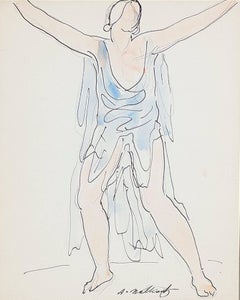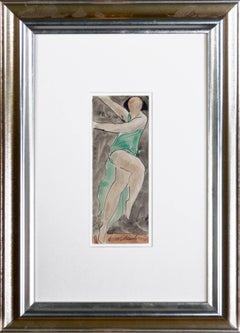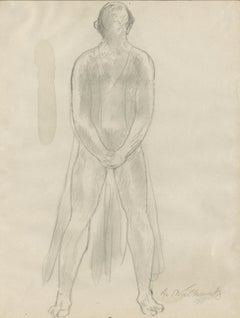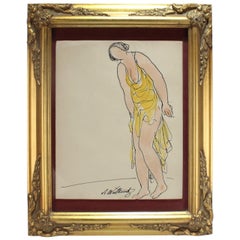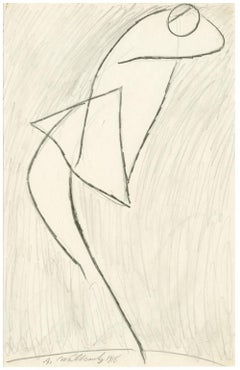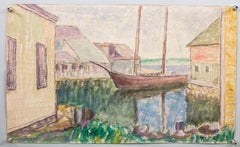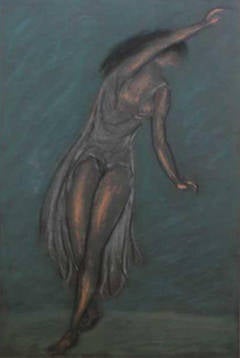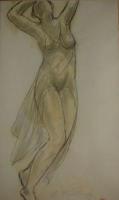Isadora Duncan Walkowitz
1920s American Modern Portrait Drawings and Watercolors
Paper, Ink, Watercolor, Graphite
1920s Modern Figurative Drawings and Watercolors
Ink, Watercolor
1910s American Modern Figurative Drawings and Watercolors
Graphite
Early 20th Century American Modern Drawings
Paper
1910s American Modern Figurative Drawings and Watercolors
Pencil
Early 1900s Post-Impressionist Figurative Drawings and Watercolors
Ink
Early 1900s Post-Impressionist Landscape Drawings and Watercolors
Watercolor
Early 1900s Post-Impressionist Landscape Drawings and Watercolors
Watercolor
1910s Abstract Landscape Drawings and Watercolors
Paper, Mixed Media
Recent Sales
1920s Drawings and Watercolor Paintings
Pastel
Late 20th Century Abstract Impressionist Drawings and Watercolor Paintings
Watercolor, Paper, Ink, Pen
1910s American Modern Figurative Drawings and Watercolors
Ink, Pen
1910s Cubist Figurative Drawings and Watercolors
Charcoal, Watercolor
Early 20th Century Figurative Drawings and Watercolors
Paper
Early 20th Century American Paintings
Paper, Watercolor
1910s American Modern Figurative Drawings and Watercolors
Graphite
1920s American Modern Figurative Drawings and Watercolors
Ink, Watercolor, Pen
1910s American Modern Figurative Drawings and Watercolors
Watercolor, Pencil
1910s American Modern Figurative Drawings and Watercolors
Ink, Pen
1910s American Modern Figurative Drawings and Watercolors
Ink, Pen, Pencil
1910s American Modern Figurative Drawings and Watercolors
Ink, Pen
1910s American Modern Figurative Drawings and Watercolors
Ink, Pen, Pencil
1910s American Modern Figurative Drawings and Watercolors
Watercolor
Vintage 1950s American Paintings
Watercolor, Paper
People Also Browsed
21st Century and Contemporary Italian Animal Sculptures
Crystal, Gold Plate, Brass
20th Century French French Provincial Patio and Garden Furniture
Cast Stone
1930s Modern Nude Prints
Lithograph
Mid-19th Century Edo Animal Drawings and Watercolors
Ink, Watercolor, Handmade Paper, Laid Paper
Mid-19th Century Romantic Figurative Prints
Watercolor, Lithograph
Antique 15th Century and Earlier Egyptian Egyptian Vases
Alabaster
Mid-18th Century Impressionist Figurative Paintings
Oil
Mid-20th Century Modern Figurative Drawings and Watercolors
Charcoal
1860s Naturalistic Figurative Paintings
Canvas, Oil
19th Century Portrait Paintings
Oil
1870s Symbolist Figurative Paintings
Canvas, Oil
Mid-18th Century Old Masters Portrait Paintings
Oil
1950s Figurative Drawings and Watercolors
Pencil
Late 20th Century American International Style Loveseats
Leather
Vintage 1960s Finnish Scandinavian Modern Desks and Writing Tables
Metal
21st Century and Contemporary Italian Busts
Marble
Isadora Duncan Walkowitz For Sale on 1stDibs
How Much is a Isadora Duncan Walkowitz?
Abraham Walkowitz for sale on 1stDibs
Abraham Walkowitz is perhaps best known for his watercolor studies of Isadora Duncan and the dance. However, Walkowitz laid claim to being the first to exhibit truly modernist paintings in the United States. After 1909, he became an intimate of Alfred Stieglitz's 291 Gallery, and while there became a participant in the debate over modern art in America. Walkowitz was an outspoken proponent of the continuous experimentation in the arts, which was his definition of modernism. As an artist, Walkowitz embodied the changing role of the modernist painter in the United States, as modernism moved from an avant-garde protest against established modes to become an accepted style and tradition.
Abraham Walkowitz was a Russian born, turn-of-the-century immigrant to the United States, who grew up in New York's Lower East Side. He first studied art at the Educational Alliance, the Cooper Union and the National Academy of Design. In 1906, he journeyed to Europe where he studied at the Académie Julian in Paris. Upon his return to the United States in 1907, he became a fully-fledged convert to modernism, and his first exhibit, at the Haas Gallery in that year, brought him a measure of notoriety as well as the attention of Stieglitz and other pioneers of non-objective art. In subsequent years, he became one of the most exhibited painters shown at the 291 Gallery, a fact which was also reflected in the pages of Stieglitz's polemical journal of modernism, camera work. As a result of this early attention, by the time of the Armory Show of 1913, to which Walkowitz contributed several paintings, his work was widely known to both fellow modernists as well as their opponents.
Walkowitz was clearly part of the new vocabulary of American art and criticism. During the 1920s and 1930s, as the first-generation modernists lost their revolutionary cast, and as American realism gained in favor, Walkowitz continued his experiments with form and line, especially in his series of Duncan studies. Although his paintings received less critical attention than they once had, Walkowitz was clearly one of the grand old folk of American modernism. During the depression, Walkowitz was politically active on behalf of unemployed artists supporting various new-deal initiatives in the arts. In the 1940s, Walkowitz gained national attention when he explored the varieties of the modernist vision in the form of an exhibit of 100 portraits of him by 100 artists. The result was widely discussed and was featured in Life magazine in 1944.
In 1945, Walkowitz traveled to Kansas, where he painted landscapes made up largely of strip mines and barns. This was his last venture in active painting — by 1946, glaucoma, which led to his eventual blindness, began to impair his vision and limit his ability to work. Walkowitz then turned to the preparation of a series of volumes of his drawings, designed to illustrate the development of modernism in the 20th century, and in so doing, established his role as a pioneer American modernist.
Finding the Right Drawings-watercolor-paintings for You
Revitalize your interiors — introduce drawings and watercolor paintings to your home to evoke emotions, stir conversation and show off your personality and elevated taste.
Drawing is often considered one of the world’s oldest art forms, with historians pointing to cave art as evidence. In fact, a cave in South Africa, home to Stone Age–era artists, houses artwork that is believed to be around 73,000 years old. It has indeed been argued that cave walls were the canvases for early watercolorists as well as for landscape painters in general, who endeavor to depict and elevate natural scenery through their works of art. The supplies and methods used by artists and illustrators to create drawings and paintings have evolved over the years, and so too have the intentions. Artists can use their drawing and painting talents to observe and capture a moment, to explore or communicate ideas and convey or evoke emotion. No matter if an artist is working in charcoal or in watercolor and has chosen to portray the marvels of the pure human form, to create realistic depictions of animals in their natural habitats or perhaps to forge a new path that references the long history of abstract visual art, adding a drawing or watercolor painting to your living room or dining room that speaks to you will in turn speak to your guests and conjure stimulating energy in your space.
When you introduce a new piece of art into a common area of your home — a figurative painting by Italian watercolorist Mino Maccari or a colorful still life, such as a detailed botanical work by Deborah Eddy — you’re bringing in textures that can add visual weight to your interior design. You’ll also be creating a much-needed focal point that can instantly guide an eye toward a designated space, particularly in a room that sees a lot of foot traffic.
When you’re shopping for new visual art, whether it’s for your apartment or weekend house, remember to choose something that resonates. It doesn’t always need to make you happy, but you should at least enjoy its energy. On 1stDibs, browse a wide-ranging collection of drawings and watercolor paintings and find out how to arrange wall art when you’re ready to hang your new works.
